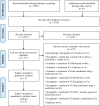Cost-Effectiveness of Saxagliptin versus Acarbose as Second-Line Therapy in Type 2 Diabetes in China
- PMID: 27875596
- PMCID: PMC5119856
- DOI: 10.1371/journal.pone.0167190
Cost-Effectiveness of Saxagliptin versus Acarbose as Second-Line Therapy in Type 2 Diabetes in China
Abstract
Objective: This study assessed the long-term cost-effectiveness of saxagliptin+metformin (SAXA+MET) versus acarbose+metformin (ACAR+MET) in Chinese patients with type 2 diabetes mellitus (T2DM) inadequately controlled on MET alone.
Methods: Systematic literature reviews were performed to identify studies directly comparing SAXA+MET versus ACAR+MET, and to obtain diabetes-related events costs which were modified by hospital surveys. A Cardiff Diabetes Model was used to estimate the long-term economic and health treatment consequences in patients with T2DM. Costs (2014 Chinese yuan) were calculated from the payer's perspective and estimated over a patient's lifetime.
Results: SAXA+MET predicted lower incidences of most cardiovascular events, hypoglycemia events and fatal events, and decreased total costs compared with ACAR+MET. For an individual patient, the quality-adjusted life-years (QALYs) gained with SAXA+MET was 0.48 more than ACAR+MET at a cost saving of ¥18,736, which resulted in a cost saving of ¥38,640 per QALY gained for SAXA+MET versus ACAR+MET. Results were robust across various univariate and probabilistic sensitivity analyses.
Conclusion: SAXA+MET is a cost-effective treatment alternative compared with ACAR+MET for patients with T2DM in China, with a little QALYs gain and lower costs. SAXA is an effective, well-tolerated drug with a low incidence of adverse events and ease of administration; it is anticipated to be an effective second-line therapy for T2DM treatment.
Conflict of interest statement
This study was funded by AstraZeneca. The funders had no role in study design, data collection and analysis, decision to publish, or preparation of the manuscript. This does not alter our adherence to PLOS ONE policies on sharing data and materials.
Figures








Similar articles
-
Cost-Utility Analysis of Dapagliflozin Versus Saxagliptin Treatment as Monotherapy or Combination Therapy as Add-on to Metformin for Treating Type 2 Diabetes Mellitus.Appl Health Econ Health Policy. 2021 Jan;19(1):69-79. doi: 10.1007/s40258-020-00603-7. Appl Health Econ Health Policy. 2021. PMID: 32783086
-
Cost-effectiveness of saxagliptin vs glimepiride as a second-line therapy added to metformin in Type 2 diabetes in China.J Med Econ. 2015;18(10):808-20. doi: 10.3111/13696998.2015.1049542. Epub 2015 Jul 1. J Med Econ. 2015. PMID: 25950193
-
Cost-effectiveness of saxagliptin (Onglyza®) in type 2 diabetes in Sweden.Prim Care Diabetes. 2012 Jul;6(2):127-36. doi: 10.1016/j.pcd.2011.09.003. Epub 2011 Oct 15. Prim Care Diabetes. 2012. PMID: 22001114 Clinical Trial.
-
Repaglinide : a pharmacoeconomic review of its use in type 2 diabetes mellitus.Pharmacoeconomics. 2004;22(6):389-411. doi: 10.2165/00019053-200422060-00005. Pharmacoeconomics. 2004. PMID: 15099124 Review.
-
Saxagliptin for the treatment of type 2 diabetes mellitus: focus on recent studies.Ann Med. 2012 Mar;44(2):157-69. doi: 10.3109/07853890.2011.603701. Epub 2011 Dec 1. Ann Med. 2012. PMID: 22132773 Review.
Cited by
-
Cost Effectiveness of Sodium-Glucose Cotransporter-2 (SGLT2) Inhibitors, Glucagon-Like Peptide-1 (GLP-1) Receptor Agonists, and Dipeptidyl Peptidase-4 (DPP-4) Inhibitors: A Systematic Review.Pharmacoeconomics. 2019 Jun;37(6):777-818. doi: 10.1007/s40273-019-00774-9. Pharmacoeconomics. 2019. PMID: 30854589
-
The validity of cost-effectiveness analyses of tight glycemic control. A systematic survey of economic evaluations of pharmacological interventions in patients with type 2 diabetes.Endocrine. 2021 Jan;71(1):47-58. doi: 10.1007/s12020-020-02489-w. Epub 2020 Sep 21. Endocrine. 2021. PMID: 32959229
-
Adverse drug events in cost-effectiveness models of pharmacological interventions for diabetes, diabetic retinopathy, and diabetic macular edema: a scoping review.JBI Evid Synth. 2024 Nov 1;22(11):2194-2266. doi: 10.11124/JBIES-23-00511. JBI Evid Synth. 2024. PMID: 39054883 Free PMC article.
-
Cost-Utility Analysis of Dapagliflozin Versus Saxagliptin Treatment as Monotherapy or Combination Therapy as Add-on to Metformin for Treating Type 2 Diabetes Mellitus.Appl Health Econ Health Policy. 2021 Jan;19(1):69-79. doi: 10.1007/s40258-020-00603-7. Appl Health Econ Health Policy. 2021. PMID: 32783086
-
Cost-Effectiveness of Newer Antidiabetic Drugs as Second-Line Treatment for Type 2 Diabetes: A Systematic Review.Adv Ther. 2023 Oct;40(10):4216-4235. doi: 10.1007/s12325-023-02612-z. Epub 2023 Jul 29. Adv Ther. 2023. PMID: 37515713 Free PMC article.
References
-
- International Diabetes Federation. IDF Diabetes Atlas, 2014 Update. Available: https://www.idf.org/sites/default/files/Atlas-poster-2014_EN.pdf. Accessed 16 April 2015.
-
- Fall CH. Non-industrialised countries and affluence. Br Med Bull. 2001; 60: 33–50. - PubMed
-
- American Diabetes Association. Standards of medical care in diabetes—2014. Diabetes Care. 2014; 37 Suppl 1: S14–S80. - PubMed
-
- Chinese Diabetes Society. Chinese guideline for type 2 diabetes prevention (2013). Chinese Journal of Diabetes. 2014; 22: 2–42.
Publication types
MeSH terms
Substances
LinkOut - more resources
Full Text Sources
Other Literature Sources
Medical
Miscellaneous

